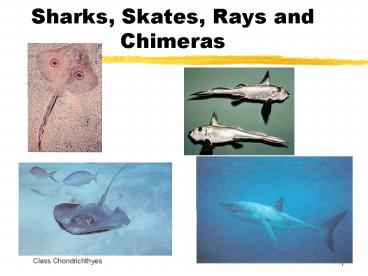Sharks, Skates, Rays and Chimeras - PowerPoint PPT Presentation
1 / 26
Title:
Sharks, Skates, Rays and Chimeras
Description:
A shark that has an air weight of 1,000 kg. weighs only 3.3kg in water ... Ganoid: Sturgeon & Paddlefish. Ctenoid. Class Chondrichthyes. 10. Feeding ... – PowerPoint PPT presentation
Number of Views:272
Avg rating:3.0/5.0
Title: Sharks, Skates, Rays and Chimeras
1
Sharks, Skates, Rays and Chimeras
2
Class Chondrichthyes
- Subclass Elasmobranchii
- Sharks
- Skates and Rays
- Subclass Holocephali
- Chimaeras (Ratfish)
- Traits
- Habitats
3
Adaptations
- Buoyancy
- Respiration
- External covering
- Feeding
- Movement
- Sensory systems
4
Buoyancy
- Huge oil-filled liver
- A shark that has an air weight of 1,000 kg.
weighs only 3.3kg in water - Lift created by a heterocercal tail
5
Caudal Fin Types
- Heterocercal
- Homocercal
6
Respiration
- Chondrichthyes employ 3 different methods of
respiration - Two pump method
- Ram ventilation
- Spiracles
7
(No Transcript)
8
External Covering
- All Chondrichthyes have placoid scales in one
form or another - Placoid scale modifications
- Spine of stingray, dorsal spine of dogfish,
defensive spines in the skate, and teeth
9
Scale Types
10
Feeding
- Most are specialized predators and have
dentition that reflects their lifestyle - Sharks that prey on fish and marine mammals have
triangular blade-like teeth - Used for grabbing and tearing
- Can exert biting pressures of 2,800 kg/cm3
- Teeth are constantly being shed and replaced
- Up to 30,000 in a lifetime
11
(No Transcript)
12
Feeding
- Digestion
- Spiral valve
13
Movement
- Pelagic sharks have rete mirabile
14
Sensory Systems
- Elasmobranchs a have well-developed sensory
system which acts in concert to locate prey and
find their way around the environment - Some species can detect a drop of blood as
dilute as 1 part per billion - Also, very good at following an odor trail
15
Sensory Systems
- Hearing
- Olfaction
- Lateral line
16
Sensory Systems
- Visual systems are well developed for use during
night and day - Tapetum lucidum increased vision at night
- Nictitating membrane
17
Sensory Systems
- Ampullae of Lorenzini
18
(No Transcript)
19
Chondrichthyes Reproduction
- Most species have extended gestation periods in
egg cases or in the body cavities of females - Young traits
- Internal fertilization, through the use of
claspers on the male
20
Chondrichthyes Reproduction
- Oviparity
- Viviparity
- Yolk-sac Viviparity
- Uterine Viviparity
- Cannibal Viviparity
- Placental Viviparity
21
Oviparity - Egg Laying
- Oviparity
22
Viviparity
- Yolk-sac Viviparity (Ovoviviparity)
- Eggs are produced and retained inside the mother
- Shell disappears and young are retained until
fully developed - Uterine Viviparity
- Mother secretes nutrient rich fluid which is
taken up through the skin of the embryo
23
Cannibal Viviparity
- Young in each oviduct consume unfertilized eggs
or other siblings
24
Placental Viviparity
- Nutrients are supplied to the embryo directly
from the mother via a umbilical cord
25
(No Transcript)
26
Chondrichthyes Life History
- Strategy of Elasmobranchs
- Produce precocial young with high survival rates
- Slow growing, long lived, and reach sexual
maturity at a late age - This reproductive strategy is why elasmobranchs
can not sustain an intensive fishery
27
Class Chondrichthyes
- Subclass Holocephali
- Possess cartilaginous skeleton, intromittent
organs, spiral valve intestine, and oil filled
liver - As a group found mostly between 80-2,600 meters,
feeding on hard shelled invertebrates































